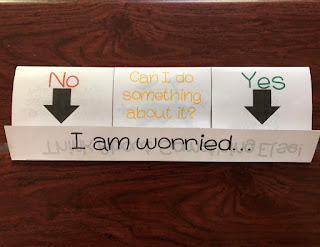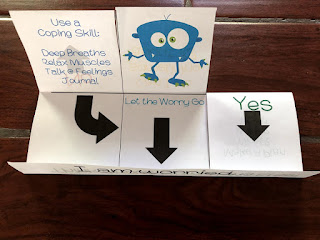I've got a bunch of students who worry a lot! They stress about asking questions in front of others, what their teacher might say, what could happen at school, or even something bad happening to their mom. It's like their minds are stuck on a loop of "what if's." It got me thinking, how can I help these kids work through their worries? I tried finding a flow chart to help, but nothing seemed quite right for elementary schoolers. So, I took matters into my own hands and created the Flip Flap Flow Chart. Let me tell you, it's been a game-changer for these worrisome kids. I've used it with them one-on-one and in my Stress Less small groups.
What's the Deal with the Flip Flap Flow Chart?
Okay, so the Flip Flap Flow Chart is a cool tool that helps my students tackle their worries head-on. It's simple to use and makes their worries easier to navigate. Here's how it works: We start by asking a crucial question - "Can I do something about this
worry?"
Taking Control of Worries:
If the answer is "yes," we lift the flap that corresponds to that question. Underneath, there are more questions that help the kids come up with a plan. They get to brainstorm and figure out what steps they can take to address their worry. Once they've got a plan, they lift the next flap and let that worry go. It's like a weight has been lifted off their shoulders! Finally, they fold down the bottom flap and shift their focus to something else. It's a way of saying, "Hey, worry, you're not taking up space in my mind anymore!"
Coping Strategies to the Rescue:
But what about those worries that are out of our control? Well, we've got a flip flap for that too! When the answer to the initial question is "no," we lift the other flap and find a bunch of strategies to help cope with those worries. The kids get to choose a strategy that resonates with them. It could be taking deep breaths, talking to a trusted adult, or maybe even drawing or writing about their feelings. Once they've picked a strategy, they lift the next flap and let that worry go too. It's amazing how a chosen coping strategy can make a difference!
Getting Creative on the Flip Side:
On the back of the Flip Flap Flow Chart, we've got even more room for creativity. We come up with coping strategies together that the kids feel will work for them when they're feeling worried. It's like a brainstorming session of ideas! By involving the kids in this process, they feel empowered to take charge of their own emotions and find coping mechanisms that suit them best.
Here are some coping strategies for kids to try:
- Deep Breathing: Take slow, deep breaths to calm the mind and body.
- Positive Self-Talk: Replace negative thoughts with positive affirmations.
- Mindfulness and Meditation: Stay present and reduce anxiety through simple exercises or guided meditation.
- Physical Activity: Engage in activities that release endorphins and reduce stress.
- Expressive Arts: Use art, writing, or music to express and process worries.
- Talk to Someone: Confide in a trusted adult for support and guidance.
- Create a Worry Journal: Write down worries to gain perspective.
- Establish a Routine: Create a structured schedule for better stability.
- Problem-Solving: Break worries into manageable parts and find practical solutions.
- Visualization: Imagine overcoming worries and achieving positive outcomes.
- Engage in Hobbies: Enjoy activities that bring joy and distract from worries.
- Practice Gratitude: Focus on the positive by expressing gratitude regularly.
Wrapping It Up:
Helping kids deal with their worries is super important. That's why the Flip Flap Flow Chart is a game-changer in my counseling office. It guides kids through their worries, gives them a sense of control, and provides coping strategies that actually work. With this tool, my students are learning to be resilient and confident in the face of their worries. So, let's equip our kids with the skills they need to conquer their worries and thrive in every aspect of their lives. They've got this!













.JPG)
.JPG)



